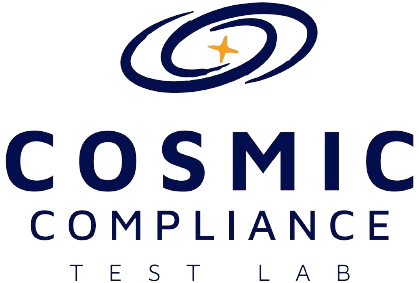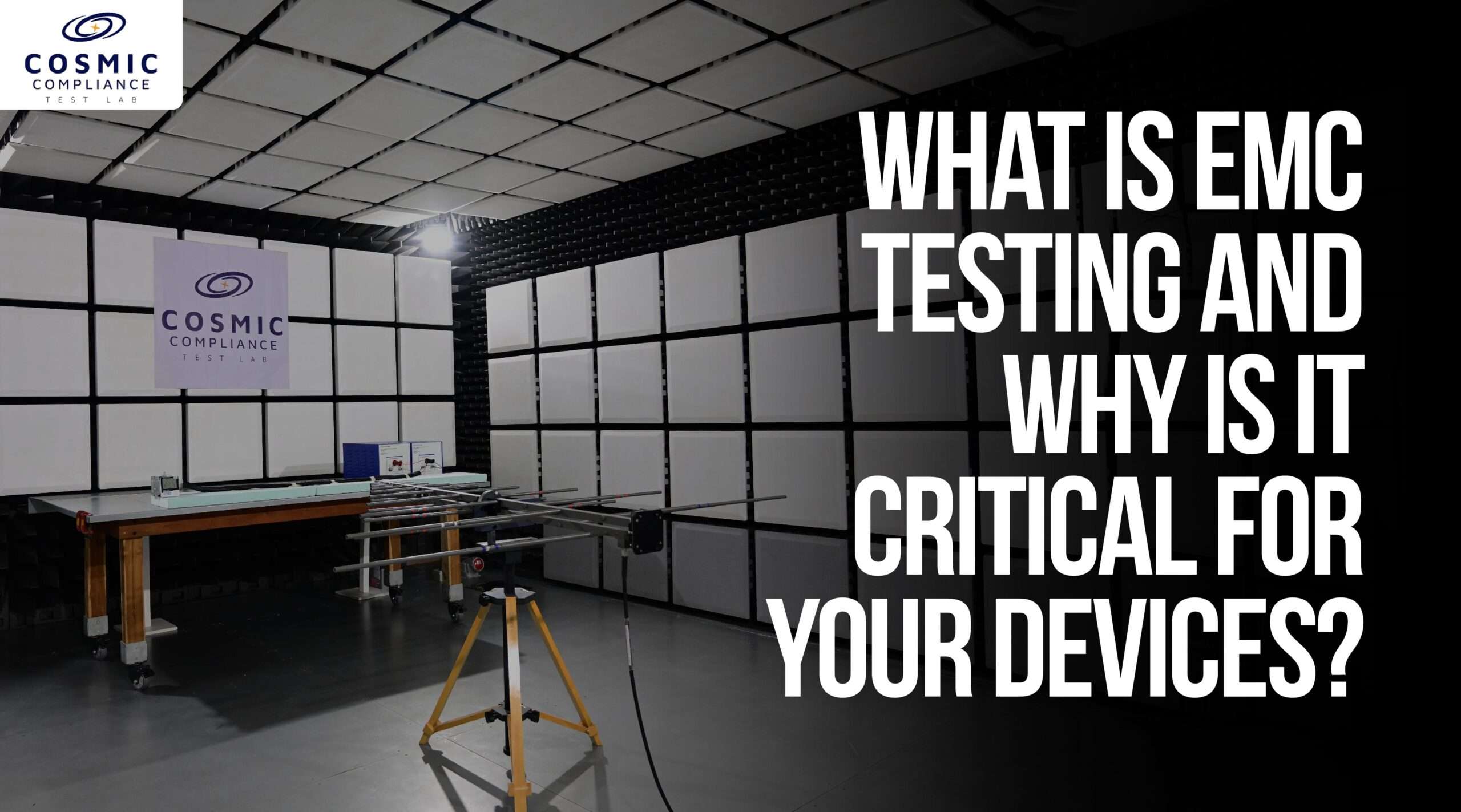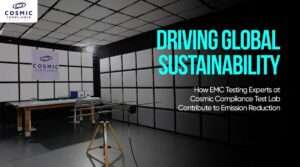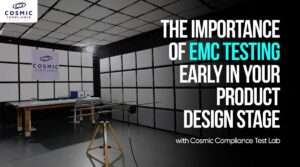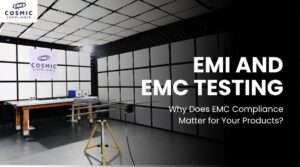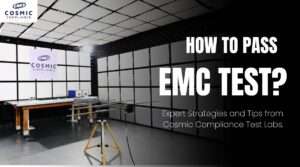Introduction
In a world driven by electronics, electromagnetic compatibility (EMC) testing is no longer optional—it’s essential. EMC testing ensures that your devices operate reliably without emitting or being affected by unwanted electromagnetic interference. Whether it’s consumer electronics, medical equipment, automotive systems, or aerospace components, electromagnetic compatibility is key to performance and safety.
At Cosmic Test Labs, we specialize in comprehensive EMC compliance solutions for a wide range of industries. In this guide, we explain what EMC testing is, why it’s crucial, and how it protects both devices and users from failure and interference.
Understanding EMC Testing
Electromagnetic Compatibility (EMC) refers to a device’s ability to function as intended without interfering with or being disrupted by other electronic systems in its environment.
- EMI (Electromagnetic Interference): Unwanted emissions from a device that can disrupt nearby equipment.
- EMS (Electromagnetic Susceptibility): A device’s sensitivity or response to external EMI.
In simpler terms, electromagnetic interference testing assesses the noise a product emits, while EMC testing also ensures the device can withstand environmental interference.
The goal of EMC testing is to verify that emissions stay within permissible limits while confirming the device can perform in various electromagnetic conditions without malfunctioning.
Why is EMC Testing Critical?
Ensuring Device Performance & Reliability
Uncontrolled electromagnetic emissions can interfere with nearby equipment, causing malfunction, data loss, or even physical damage. EMC testing helps ensure your product maintains stable performance even in high-EMI environments, which is vital for industries like medical devices and aerospace.
Regulatory Compliance & Legal Requirements
Global regulations such as:
- FCC (USA)
- CE (Europe)
- CISPR (Global)
- IEC 61000 series
mandate EMC compliance for market entry. Non-compliance can lead to legal consequences, product recalls, and loss of certification.
Preventing Safety Hazards
Interference in life-critical systems—like pacemakers, automotive electronics, or aircraft controls—can pose serious safety risks. Electromagnetic compatibility testing is essential to ensure these systems function without disruption.
Enhancing Market Acceptance & Competitiveness
EMC compliance builds trust and confidence. Customers and distributors prioritize products that meet recognized EMC standards, making your product more competitive in both domestic and international markets.
Types of EMC Testing
When electronic devices are tested for Electromagnetic Compatibility (EMC), they go through two main types of tests: Emission Testing and Immunity Testing. These tests make sure your device works properly without interfering with other devices and can handle interference from other sources too.
1. Emission Testing: Does Your Device Leak Interference?
This checks whether your device gives off too much electromagnetic energy, which can affect nearby equipment like TVs, Wi-Fi routers, or medical instruments.
- Radiated Emissions:
This test measures any radio frequency (RF) energy that your device gives off into the air while it’s working. Think of it like checking if your device is “shouting” unwanted signals. - Conducted Emissions:
This looks at interference that travels along power cords or data cables. These signals can travel through wiring and disturb other electronics connected to the same power line.
These tests make sure your device stays within legal limits and doesn’t “pollute” its environment with too much electromagnetic noise.
2. Immunity (Susceptibility) Testing: Can Your Device Withstand Interference?
Here, the focus is on whether your device can continue working normally even when it’s exposed to external electromagnetic disturbances.
- Radiated Immunity:
This test bombards your device with radio waves to see if it can resist interference from things like mobile phones, wireless signals, or nearby electronics. - Conducted Immunity:
Here, the device is tested against noise that might come through connected cables or power lines. It checks if such disturbances affect its performance. - Electrostatic Discharge (ESD):
This simulates static electricity—like when you touch a metal doorknob after walking on carpet. It helps test if the device can handle shocks from human contact or nearby surfaces without crashing or malfunctioning.
3. Other Common EMC Tests
- Surge Testing:
This test simulates sudden spikes in voltage—like what might happen during a lightning strike or power surge. It checks if the device can survive those spikes without damage. - Voltage Dips and Interruptions:
Sometimes, your electricity supply might momentarily dip or cut out. This test sees if your device can recover from such power hiccups without failing. - Harmonic Distortion Testing:
When a device draws power in a non-smooth (non-linear) way, it can affect the overall power quality. This test checks if your device adds distortion to the power supply that could mess with other connected equipment.
EMC Testing Process: How It Works
Understanding how EMC testing is done can help you build better, more reliable products that meet global standards. Here’s a breakdown of the process in simple terms:
1. Pre-Compliance Testing: Catch Problems Early
This is the first step in the EMC testing journey and is done during the design phase of your product.
- Why it matters:
Think of this like a practice round. Pre-compliance testing helps you spot electromagnetic interference (EMI) problems before your product is fully built. - Benefits:
By identifying issues early, you can make changes before it’s too late—saving you from costly redesigns, delays, or failed tests later on. - How it’s done:
Using smaller test setups, engineers check emissions and immunity levels to make sure everything is heading in the right direction.
2. Compliance Testing & Certification: The Final Exam
Once the product is finalized, it’s time for the real test—compliance testing. This is done at professional, accredited labs like Cosmic Test Labs to ensure your product meets international EMC standards.
- What happens during this stage:
- Your device is placed inside a special room called an anechoic chamber, which blocks external signals and prevents reflections.
- Highly sensitive instruments measure how much electromagnetic energy your device emits, and how well it can resist interference.
- These results are compared with global or industry-specific regulations like FCC, CE, CISPR, or others depending on your market.
- Goal:
To receive an official certification showing that your product is safe, compliant, and ready for the global market.
3. Mitigation Strategies: Fixing EMC Problems
If your device fails any EMC tests, don’t worry—there are proven ways to fix the issues.
Here are some common solutions:
- Shielding:
This involves using metal or special materials around sensitive parts of your device to block harmful electromagnetic waves from leaking out or getting in. - Filtering:
Filters are added to power or signal lines to reduce unwanted interference that may travel through cables. - Grounding:
This means safely directing unwanted electrical noise away from the device through proper wiring, keeping performance stable and reducing interference.
Bonus: Design Consultation with Cosmic Test Labs
At Cosmic Test Labs, we don’t just test your products—we help you build them right from the start. Our experts offer EMC design consultation to help you apply these best practices during the early stages of development. This ensures smoother testing, faster approvals, and a better end product.
EMC Testing Standards and Regulations
Here’s a quick overview of key EMC regulations:
- FCC – Regulates radiofrequency devices in the U.S.
- CE Marking – Mandatory for selling electronics in the EU.
- CISPR – Global radio interference standards from the IEC.
- MIL-STD-461 – U.S. military EMC compliance.
- IEC/EN 61000 series – International standards for EMC emissions and immunity.
We ensure full adherence to these guidelines, providing documentation and test reports required for global certification.
Challenges in EMC Testing and How to Overcome Them
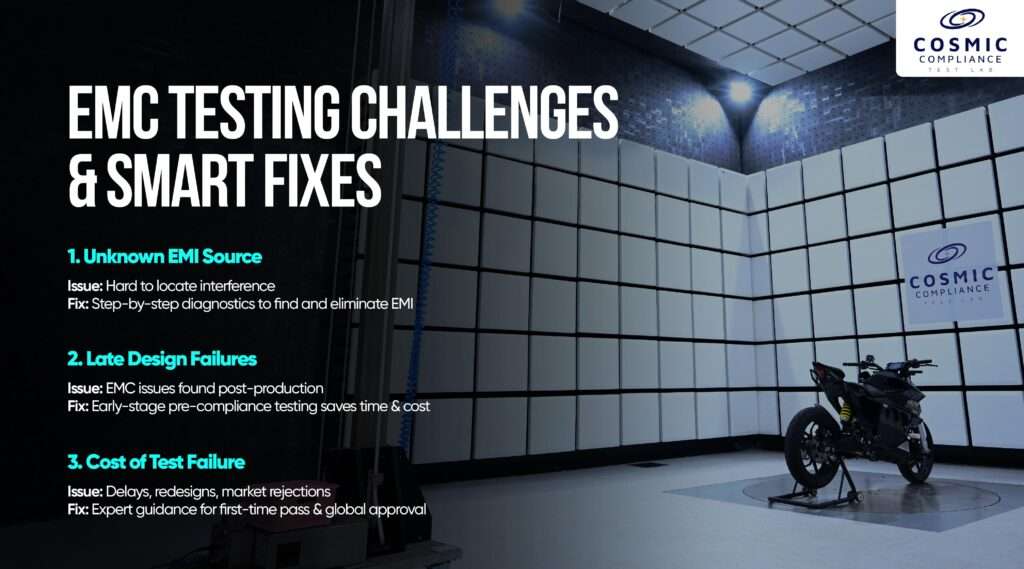
EMC (Electromagnetic Compatibility) testing is essential, but it can come with its fair share of challenges—especially when your device is packed with electronic parts or operates in a noisy electrical environment. Let’s break down some common problems and how to deal with them in a practical, stress-free way.
1. Trouble Finding the Source of Interference
- The problem:
Sometimes, your device starts misbehaving due to electromagnetic interference (EMI), but it’s hard to tell where the interference is coming from. - The fix:
At Cosmic Test Labs, our experts follow a step-by-step troubleshooting approach using advanced tools to track down the exact source of the problem—whether it’s a circuit, a cable, or an external device. Once we find it, we help you fix it.
2. Design Failures Found Too Late
- The problem:
If EMC issues are only discovered after the product is fully built, it can lead to delays, extra costs, or even a full redesign—pushing your launch date further. - The fix:
The key is to start testing early in the design phase. We offer pre-compliance testing to catch problems before they grow. This saves you time, money, and frustration.
3. The Cost of Failing EMC Tests
- The problem:
Failing an EMC test doesn’t just mean fixing the problem—it can mean expensive redesigns, missed deadlines, and market delays. In some cases, products even get rejected from entering certain countries. - The fix:
By working with a trusted lab like Cosmic Test Labs, you’re guided by experienced professionals who help ensure your product meets EMC requirements the first time. Our team supports you through design, testing, and certification, helping you avoid rework and speed up time-to-market.
EMC testing doesn’t have to be a roadblock. With the right guidance and a proactive approach, you can overcome these challenges and bring high-performing, compliant products to market faster.
Conclusion
In an increasingly connected world, EMC testing is essential to ensure your devices are safe, reliable, and compliant with international standards. It protects your products from interference, helps avoid costly recalls, and enhances customer trust.
Cosmic Test Labs delivers certified, end-to-end EMC testing services—helping you identify issues early, meet global compliance, and confidently bring your product to market.
Call to Action
Looking for certified EMC testing services?
Partner with Cosmic Test Labs for reliable, professional electromagnetic compatibility assessments that meet global regulatory standards.
👉 Get in touch with our team today for a consultation and quote.
